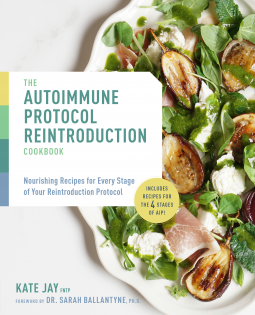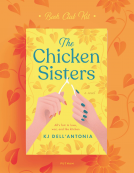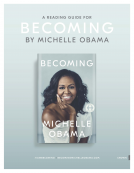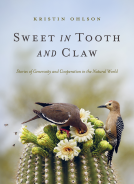
The Autoimmune Protocol Reintroduction Cookbook
Nourishing Recipes for Every Stage of Your Reintroduction Protocol - Includes Recipes for The 4 Stages of AIP!
by Kate Jay
This title was previously available on NetGalley and is now archived.
Send NetGalley books directly to your Kindle or Kindle app
1
To read on a Kindle or Kindle app, please add kindle@netgalley.com as an approved email address to receive files in your Amazon account. Click here for step-by-step instructions.
2
Also find your Kindle email address within your Amazon account, and enter it here.
Pub Date May 25 2021 | Archive Date Apr 13 2021
Quarto Publishing Group – Fair Winds | Fair Winds Press
Talking about this book? Use #TheAutoimmuneProtocolReintroductionCookbook #NetGalley. More hashtag tips!
Description
You made it through the elimination period of the autoimmune protocol (AIP) diet, but now what? The Autoimmune Protocol Reintroduction Cookbook shows you how to successfully implement and track the reintroduction of inflammatory foods through all four stages with appropriate recipes and food lists.
The AIP diet is quickly gaining ground as the top health-supportive diet for autoimmune conditions. To follow this elimination diet, inflammatory foods are removed for 30–90 days. After the elimination period, the foods are then reintroduced in four stages to see if they can be tolerated. While eliminating foods can be daunting, the reintroduction phase of the diet is the most anxiety-provoking and failure-prone part of the process for AIP followers. Each stage of the reintroduction must be done methodically and carefully so that an autoimmune flare is not triggered.
AIP Certified Coach Kate Jay of the popular blog Healing Family Eats eases the challenge of reintroduction by guiding you step by step through every stage. One hundred tantalizing recipes, divided by stage, add pleasure to the process. Enjoy:
- Spice-Spatchcocked Chicken with Lime Gravy (Stage 1)
- Pear, Raspberry, and Cardamom Galette (Stage 1)
- Roasted Pomegranate Carrots on Whipped Tahini (Stage 2)
- Strawberry Vanilla Chia Seed Parfait (Stage 2)
- Lentil Ragu on Rutabaga Noodles (Stage 3)
- Blackberry Streusel Muffins (Stage 3)
- Vietnamese Pork with Noodles and Roasted Peanuts (Stage 4)
- Rice Pudding with Blood Orange and Saffron (Stage 4)
Along with the recipes and food lists, she offers best practices and troubleshooting advice, including how to handle an unsuccessful food reintroduction and when the next stage can be introduced.
Let The Autoimmune Protocol Reintroduction Cookbook be your reassuring companion as you take the next step in your AIP journey.
Available Editions
| EDITION | Other Format |
| ISBN | 9781592339730 |
| PRICE | $26.99 (USD) |
| PAGES | 208 |
Featured Reviews
 Elizabeth Ann S, Reviewer
Elizabeth Ann S, Reviewer
An essential guide for anyone with an autoimmune disease (I have Rheumatoid Arthritis) and already done/tried the elimination process and at a loss of how to precede. I should point out that I read it from a UK perspective so some of the ingredients are a little unusual but luckily the recipes include measurements in grams so make them easy to follow. Also my elimination diet also excluded some of the things allowed in Kate's diet, namely red meats being not allowed but Kefir being allowed however, the concept is the same and, as Kate point's out the problem is so individualistic.
It certainly gives the reader confidence to try and get on top of the problem through diet and, hopefully, ditch the drugs in the future. There is advice on troubleshooting and how problems of reintroduction can manifest slightly differently within the body. All helpful stuff. Most of the recipes have accompanying photos and look easy to follow provided one can access the ingredients, some of which might be a little beyond me but could easily be substituted. Maybe, Kate could consider doing a UK friendly version as I note she was originally from this side of the Atlantic!
Some of these recipes seem impractical unless you’re willing to keep a lot of uncommon ingredients in your kitchen, but several extremely accessible. It gives a nice background on AIP, what you should and shouldn’t eat, and reintroduction. This shouldn’t be your first introduction to AIP but it’s a good resource to have.
 Rebecca C, Bookseller
Rebecca C, Bookseller
Kate Jay lines out recipes for each step of reintroduction a in the post AIP elimination phase. She uses beautiful photography and complex flavor combinations to make AIP exciting. I really enjoyed the reinto box in the bottom corner of each recipe page. Each one lists what stage, which ingredient is a reintro and how to make it elimination phase compliant (if possible). She often calls for uncommon ingredients, such as celeriac, white sweet potatoes, tigernut flour and fenugreek, things I am not able to get at my local grocery store. If you are on an AIP Protocol and enjoy gourmet food, this book will give you lots of ideas.
 Beth B, Reviewer
Beth B, Reviewer
I love how Jay categorizes the recipes based on the different reintroduction phases/foods - makes it so easy to figure out WHAT you can eat. There were some odd ingredients in some of the recipes, but overall, really useful.
 Tara C, Librarian
Tara C, Librarian
I wish I had this cookbook about 6 years ago when I was first diagnosed with Lupus. The layout and design are both clean and clear, but enticing photos tempt as foods are reintroduced. It is so hard to eat when you are eliminating food groups from your diet. It is emotional., even heartbreaking at times. But these recipes seem simple enough with ingredients that are a bit strange (cassava flour), but something you could easily find at a local grocery store. The composed dishes are easy enough for a weeknight, and some are special enough to serve to guests. Desserts aren't seen as taboo, and classics are reimagined to be nutritious and gut-friendly. Honestly, you'll be healthier and emerge as an improved cook from this book!
Kate Jay is a Functional Nutritional Therapy Practitioner, Certified Gluten Practitioner, Restorative Wellness Practitioner, and AIP Certified Coach. Her cookbook begins with some kitchen basics, including a discussion of discussion of common ingredients, a guide to soaking and sprouting, and a table of common conversions. Following is a brief explanation of the Autoimmune Protocol (AIP), including lists of foods to eat and foods to avoid. The second chapter discusses how to reintroduce foods in four stages. The AIP is complicated, so I wouldn’t recommend attempting it using only this book, but I do think this book will be a helpful resource, especially during the reintroduction process.
If you’re not used to eating a restricted diet, some of the ingredients may seem exotic, but most of them shouldn’t be too hard to find. I can find coconut aminos, arrowroot starch, and cassava flour in some of my local grocery stores, but if you can’t find them locally, you can always order them online.
The recipes are organized by stage of reintroduction. They are clearly written with helpful notes and include number of servings, prep time, and cook time. Each has a sidebar highlighting the ingredient(s) being reintroduced, whether the recipe is freezer friendly, whether it is low FODMAP, and whether it is free of coconut. Most also include suggestions for how to make the recipe fully AIP compliant. Most recipes are also accompanied by a gorgeous photograph of the finished dish. The recipes do not include nutritional data if that is important to you (I have to count carbs for my diabetes, and that was tricky with some of these recipes.)
So, how do the recipes taste? Not bad, especially if you are used to following a restricted diet. Some might not appeal to those who don’t have a compelling reason to want to follow a nutrient-dense, anti-inflammatory diet, but for anyone with chronic health problems, it might be worth giving this a try. Some of the recipes turned out well enough that I would happily serve them to friends and family who aren’t on the AIP.
The No Oats Oatmeal was delicious, although thinner than a bowl of oatmeal would be. The author recommends serving this dish immediately, but I thought the leftovers were even better. The NY Steak was excellent—it’s a dish I would proudly serve to loved ones for a special occasion. The Chia Seed Parfait made a very satisfying dessert. It’s smooth, creamy, and absolutely delicious, as well as very attractive served in a pretty glass. The “Cheesy” Chicken & Broccoli Bake was not very exciting, but it was ok. The sauce was delicious raw, but less appealing in the final dish. The Chicken Kiev was amazing. Using crushed plantain chips in place of breadcrumbs was a stroke of genius, and something I am likely to use in other recipes. (Note that the sidebar had incorrect information for this recipe in my review copy—hopefully that’s been corrected in the published version.) We didn’t care for the Papaya Lassi as written, but it was much nicer once we added some peaches. I had never had papaya before, so perhaps there was something wrong with ours, or maybe I just don’t like papaya.
The back matter includes additional resources for autoimmune health and an index that includes both ingredients and recipe names.
My overall impression is that while some of the recipes looked complicated or required unusual ingredients, this cookbook offers some nice choices for those wanting to try the AIP to treat autoimmune disease or other chronic illnesses, or for those living with multiple food intolerances. It can be tricky to find recipes for the reintroduction stage of the AIP, so this is a welcome resource.
I was provided an ARC through NetGalley that I volunteered to review.
Readers who liked this book also liked:
Silvia Moreno-Garcia
Historical Fiction, Literary Fiction, Sci Fi & Fantasy


















